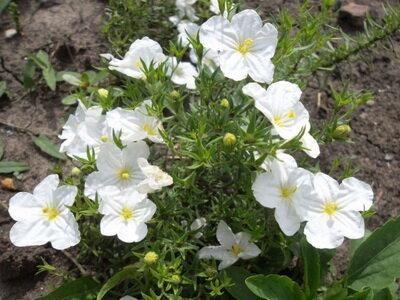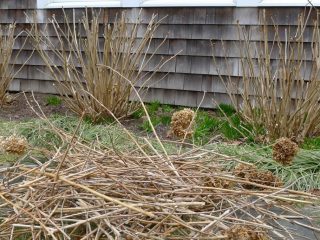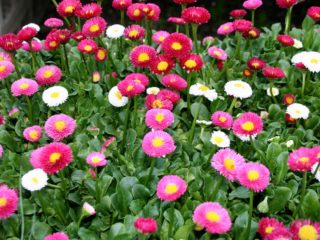Content
- 1 Description of Nirembergia
- 2 Types and best varieties
- 3 When to plant Nirembergia seedlings
- 4 Sowing Nirembergia seeds for seedlings
- 5 Planting Nirembergia in open ground
- 6 Caring for Nirembergia in the open ground
- 7 Diseases and pests
- 8 Application in landscape design
- 9 Conclusion
- 10 Reviews about growing Nirembergia
To plant and grow Nirembergia, you need to know which variety to choose and how to properly care for it in open ground. Unpretentious flowers can become a real decoration of a landscape area. Photos and descriptions of Nirembergia will help you choose the best option for arranging your garden.

The plant will help to create a beautiful flower garden, decorate a rock garden and a ridge
Description of Nirembergia
The basic description of the plant, which will allow you to learn about Nirembergia, consists of the following characteristics:
- The plant forms a compact bush consisting of many highly branched creeping or ascending shoots.
- Nirembergia flower is a perennial belonging to the Solanaceae family. In suitable climatic conditions it grows intensively and reaches a height of 60 cm.
- The leaves are alternate, elongated, narrow, dark green in color. They can be planted on short cuttings or attached directly to the stem.
- At the tops of the shoots there are single flowers, consisting of five wide-open petals in a blue, white, lavender or purple palette. They are either sessile or located on short peduncles.
- After flowering, fruits are formed in their place - bivalve boxes with small seeds.

Nirembergia flower comes from Latin America, where it grows beautifully in open ground for many years in one place
Types and best varieties
In total, more than 30 species of Nirembergia flowers are known. Their natural habitat is the tropics and subtropics. Modern varieties are unpretentious, sun-loving and drought-resistant, ideal for creating a picturesque composition.
Nirembergia blue
Nirembergia blue Shining Crystal is a profusely flowering groundcover with creeping stems 20 cm high. They are thin, elongated, climbing, densely covered with leaves. The leaf blades are elongated, oblong, dark green in color. The buds are 3 cm in diameter and consist of five petals of white or violet-purple color with a yellow core. The flowering period occurs at the beginning of summer and lasts until September.

In the middle zone and in the northern regions, the blue nirembergia flower is grown as an annual in the flower garden and at home in pots
Nirembergia rodiformis
This variety appears in the form of a compact openwork shrub up to 30 centimeters high. The shoots are thin, branching. The leaves are lanceolate, lush green in color, located along the entire length of the stem in an alternate order.Cup-shaped five-petal flowers of a lilac hue with longitudinal dark purple veins.

The twig-shaped Nierembergia flower (Nierembergia scoparia) decorates sunny flower beds all summer
Nirembergia fruticosa
This plant is a low shrub characterized by abundant and long-lasting flowering. Nirembergia stems spread along the ground and form dense green spaces. The leaves of the crop are linear, grassy green in color. The inflorescences are from 2.5 to 3 cm in size, located at the tops of the stems, represented by a blue, lilac and white palette with a contrasting yellow center. This species is often used for landscaping rock gardens.

Nirembergia shrub flower pleases with its bright blooms until late autumn
Nirembergia subtle
This species forms a subshrub that reaches 30 centimeters and has the shape of a ball. The shoots are long and thin, with luxurious foliage. Leaves with a carved border along the edges, rich green in color. The petals are snow-white, decorated with longitudinal purple stripes. The flowering period occurs in June and lasts until the first frost.

Thin Nierembergia (Nierembergia gracilis) is a delicate and graceful plant, as if created to decorate the garden
Nirembergia hippomanensis
This light-loving and moisture-loving plant comes from Brazil. Nirembergia flower develops well in open ground in the southern regions, Central Black Earth and Central regions. However, it is rarely found in Russian gardens. It blooms all summer until September with delicate white, purple or blue flowers with slightly pointed tips.

Nierembergia hippomanica flower has narrow linear leaves
Nirembergia repens
Nierembergia repens produces luxurious snow-white cupped flowers on carpets of small dark green leaves. Blooms vigorously throughout the summer season. It grows quickly, filling the entire soil space. For this reason, it is great for confined areas.
The Nirembergia variety, White Mantle, up to 90 cm high with large white flowers that look bright against the background of dark green foliage, deserves special attention.

The culture prefers moist, drained soil and semi-shaded places.
When to plant Nirembergia seedlings
The most favorable period for sowing seeds is March-April. But gardeners in the southern regions can sow them as early as February. However, it is important to consider that seedlings develop slowly; on average, 3.5 months pass from sowing to flowering.
Sowing Nirembergia seeds for seedlings
The Nirembergia flower reproduces well by seeds, which means that even inexperienced gardeners can sow.
Scheme for planting flower seeds for seedlings:
- First you need to prepare a container with drainage holes at the bottom.
- Fill it with a 2 cm thick layer of perlite and pour universal soil for flowering plants on top.
- Nirembergia seeds are very small, and for convenient distribution you can mix them with river sand, which must first be disinfected.
- The seeds should be sprinkled with a thin layer of substrate 8-10 cm thick and sprayed with a spray bottle.
- Cover the container with the plantings with transparent glass or film to create a greenhouse effect and place in a warm, bright place.
- After about two weeks, shoots will appear and the cover will need to be removed.
- In order for the seedlings to become strong, grow amicably and quickly, you need to regularly water them from a watering can and feed them with mineral fertilizers, for example, potassium nitrate.
- After two true leaves appear, the plants should be planted in separate cups.
In order for seedlings to quickly adapt to open ground, approximately two weeks before transplanting into the ground, they should be taken out to the loggia for 30-40 minutes
Planting Nirembergia in open ground
In the middle zone, flower seedlings are planted in open ground in May-June, as soon as the return frosts have passed. In the southern regions, the dates are shifted back two weeks, and in cold regions - forward.
Landing algorithm:
- Dig holes, maintaining a distance of 30 cm between them.
- The seedlings are carefully removed from the pots along with the root ball.
- The plants are placed in the holes and the roots are sprinkled with soil, trying not to leave any voids. The soil in the area of the stems is carefully compacted with your hands.
After planting the seedlings, water and mulch with sawdust.
Caring for Nirembergia in the open ground
Nirembergia flower needs simple care and suitable growing conditions. It is important to observe the norm of watering: excessive moisture and drying out of the soil adversely affects the development of the plant and flowering. Watering is carried out twice a week in the morning or evening.

In hot summers with a long absence of rain, the frequency of watering the flower is increased.
In addition to watering and fertilizing, the nirembergia flower requires pinching, as well as the removal of faded inflorescences to maintain spectacular flowering
Diseases and pests
This culture has strong immunity. With proper care, it is not affected by fungi and viruses. Among harmful insects, the most dangerous are aphids and whiteflies. To preserve the flower, at the first signs of pest activity, you need to treat it with Topaz.
Application in landscape design
A photo of Nirembergia demonstrates all the beauty of the plant in the garden. Small, beautifully flowering bushes look great in flowerpots where they cascade beautifully. They are good in group and single plantings.

A varied palette allows you to experiment, creating a picturesque flower garden according to your preference
This plant goes well with pink petunia, lobelia, snapdragon, yellow marigold and other annual crops.

Designers love to use the Nirembergia flower in landscape design, combining low-growing species and varieties with long shoots
Conclusion
In order not to suffer from choosing a variety, it is worth studying in detail the photo and description of Nirembergia. Breeders continue to work on developing new varieties. You can easily get lost in their variety of shapes and shades.
Reviews about growing Nirembergia



















